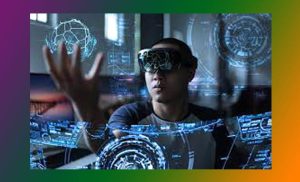Virtual Reality
Virtual Reality (VR): Immersing into Digital Realms
Introduction:
Virtual Reality (VR) has emerged as a groundbreaking technology, transporting users into immersive digital environments. This essay explores the core concepts of virtual reality, its applications, impact on various sectors, challenges, and the promising future it holds for transforming how we experience and interact with the digital world.
Defining Virtual Reality:
Virtual Reality is a computer-generated simulation of a three-dimensional environment that users can interact with using special devices. It strives to replicate an immersive experience, making users feel as though they are physically present in the simulated environment.
Key Components of Virtual Reality:
Hardware: VR experiences are delivered through specialized hardware, including VR headsets and motion controllers. These devices track users’ movements, adjust visual elements in real-time, and create a sense of presence in the virtual environment.
Software: VR software includes applications, games, simulations, and other interactive content designed to provide immersive experiences. The software is often developed using 3D modeling, animation, and programming techniques.
Applications of Virtual Reality:
VR’s applications span a wide range of fields, transforming how we learn, work, and entertain ourselves.
Gaming: VR gaming immerses players in virtual worlds, providing a heightened sense of presence and interactivity. Games often utilize motion controllers to allow users to manipulate virtual objects.
Education and Training: VR enhances education and training by providing realistic simulations. Medical students can practice surgeries, pilots can simulate flights, and employees can undergo immersive training in various industries.
Healthcare: VR is used for therapeutic purposes, such as treating phobias and anxiety disorders. It also aids in pain management and rehabilitation by creating immersive and engaging environments.
Impact on Industries:
Real Estate: VR facilitates virtual property tours, allowing potential buyers to explore homes and spaces remotely. Architects and designers use VR to visualize and present projects in a more immersive way.
Tourism: Virtual tours and experiences enable users to explore destinations before planning a trip. VR transports users to different locations, providing a taste of the travel experience.
Design and Manufacturing: VR is employed in product design and prototyping, allowing engineers and designers to visualize and interact with 3D models in a virtual space.
Challenges in Virtual Reality Implementation:
Sensory Feedback: Achieving realistic sensory feedback, such as touch and smell, remains a challenge in VR technology. Current devices primarily focus on visual and auditory experiences.
Motion Sickness: Some users may experience motion sickness or discomfort in VR, a challenge that developers are addressing through improved hardware and software optimization.
Accessibility and Affordability: High-quality VR hardware can be expensive, limiting accessibility. As technology advances, efforts are being made to create more affordable and user-friendly VR solutions.
The Future of Virtual Reality:
The future of VR holds exciting possibilities, with advancements in hardware, content creation, and integration with other emerging technologies.
Social VR: Collaborative virtual spaces and social VR experiences are gaining traction, allowing users to interact with others in a shared virtual environment.
Medical Applications: VR is expected to play a more significant role in medical therapy and rehabilitation, offering personalized and immersive interventions.
Conclusion:
Virtual Reality is not merely a technological novelty; it is a transformative force reshaping how we experience and interact with digital content. As we navigate the realms of virtual reality, addressing challenges, fostering innovative applications, and embracing the transformative potential of VR for various industries will be essential. In the vast landscape of technology, virtual reality stands as a gateway to immersive digital experiences, offering a glimpse into a future where the boundaries between the real and the virtual seamlessly converge for the benefit of individuals and societies. 0 0 0.
N.B. The article originally belongs to the book ‘Select Essays on Technology‘ by Menonim Menonimus.
You May Like:
- What is Website-A Comprehensive Study
- Wearable Technology
- List of Websites for Students
- Tips for Best SEO
Additional Searches:











